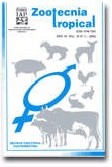
|
Zootecnia Tropical
Instituto Nacional de Investigaciones Agrícolas Venezuela
ISSN: 0798-7269
Vol. 28, No. 1, 2010, pp. 65-72
|
 Bioline Code: zt10009
Bioline Code: zt10009
Full paper language: English
Document type: Research Article
Document available free of charge
|
|
|
Zootecnia Tropical, Vol. 28, No. 1, 2010, pp. 65-72
| en |
Biochemical composition of the freshwater shrimp Macrobrachium jelskii  (Miers, 1877) under culture conditions (Miers, 1877) under culture conditions
Ramírez, Enmary; Silva, Annie; Guevara, Miguel; Núñez, Maximiano; Bauza, Richard & Arredondo-Vega, Bertha
Abstract
The freshwater shrimp Macrobrachium jelskii

is a very abundant resource in the zone of the Delta of the
Orinoco, with ability to reproduce in culture lagoons and without useful at the present time. In the present
investigation the content of protein, carbohydrates, lipids and fatty acids of this shrimp, was analyzed under
culture conditions, with the purpose of quantifying and categorizate its bromatological composition, and thus
defining its possible industrial advantage, like raw material for the concentrated food elaboration for animals. The
protein analyses, carbohydrates and lipids, were made through espectrophotometric methods and the fatty acid
profile was determined by gas chromatography connected to spectrometry of masses. The analyses determined
that the concentrations of proteins, total carbohydrates and lipids, on the basis of dry mass, were increased during
the development of the investigation, varying their contents from 34,74±2,39 to 57,70±5,75%; from 0,64± 0,07
to 3,43±0,40% and 9,90±0,9 to 11,40±1,30%, respectively. The values of fatty acids obtained in M. jelskii , varied between 35,93 – 51,42% for the saturated; 21,00 – 25,49% for monounsaturated and 23,09 – 38,8%
for poliunsaturated. Finally, it is important to emphasize that the culture of M. jelskii in fish cultured lagoons,
maintained with food of low cost, allows to obtain biomass with high nutritional content, which could be used as
ingredient for the concentrated food formulation for fish and crustaceans in aquaculture
Keywords
Macrobrachium jelskii, chemical analysis, shrimps.
|
| |
| es |
Composición bioquímica del camarón dulceacuícola Macrobrachium jelskii  (Miers, 1877) sometido a condiciones de cultivo (Miers, 1877) sometido a condiciones de cultivo
Ramírez, Enmary; Silva, Annie; Guevara, Miguel; Núñez, Maximiano; Bauza, Richard & Arredondo-Vega, Bertha
Resumen
El camarón dulceacuícola Macrobrachium jelskii

es un recurso muy abundante en la zona del Delta del Orinoco,
con capacidad de reproducirse en lagunas de cultivo y sin aprovechamiento en la actualidad. En la presente
investigación se analizó el contenido de proteínas, carbohidratos, lípidos y ácidos grasos de este camarón, sometido
a condiciones de cultivo, con la finalidad de cuantificar y categorizar su composición bromatológica, y así definir
su posible aprovechamiento industrial como materia prima para la elaboración de alimentos concentrados para
animales. Los análisis de proteínas, carbohidratos y lípidos, se realizaron a través de métodos espectrofotométricos
y el perfil de ácidos grasos se determinó mediante cromatografía de gases acoplada a espectrometría de masas.
Los análisis realizados determinaron que las concentraciones de proteínas, carbohidratos y lípidos totales, en base
a masa seca, se incrementaron durante el desarrollo de la investigación, variando sus contenidos desde 34,70±2,39
hasta 57,74±5,75%; desde 0,64± 0,07 hasta 3,43±0,40% y desde 9,90±0,90 hasta 11,40±1,30%, respectivamente.
Los valores de ácidos grasos obtenidos en M. jelskii variaron entre 35,93 - 51,42% para los saturados; 21,00 -
25,49% para los monoinsaturados y 23,09 - 38,80% para los poliinsaturados. Finalmente, es importante resaltar
que el cultivo de M. jelskii en lagunas piscícolas, mantenido con alimento de bajo costo, permite obtener biomasa
con elevado contenido nutricional, la cual pudiera ser usada como ingrediente para la formulación de alimentos
concentrados para peces y crustáceos sometidos a cultivo.
Palabras-clave
Macrobrachium jelskii, análisis bioquímico, camarones.
|
| |
© Copyright 2010 - Zootecnia Tropical
Alternative site location: http://www.sian.inia.gob.ve/repositorio/revistas_ci/ZootecniaTropical/ztindice.htm
|
|
